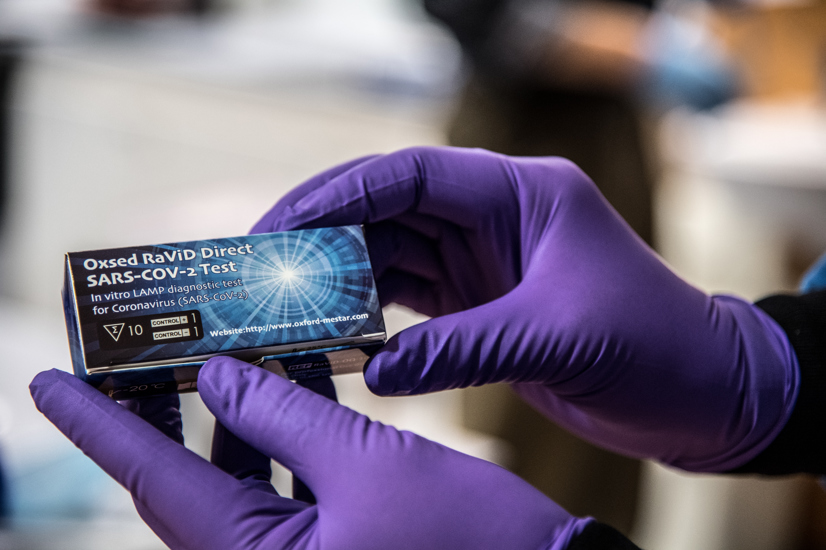17 Aug 2020
Oxford developers of rapid Covid-19 test awarded RAEng President's Special Award
Professor Cui and his team are one of the winners of the Royal Academy of Engineering's President's Special Awards for Pandemic Service for their rapid viral RNA test for COVID-19

Image credit: Jude Palmer/Royal Academy of Engineering
When China began lockdown, University of Oxford researchers at OSCAR, the Oxford Suzhou Centre for Advanced Research, began work on a speedy test to identify carriers of COVID-19 and provide a result within 30 minutes. The rapid RNA test they devised in record time can detect whether a person is infected with the virus and is still infectious - and because no labs are needed it could be used with huge benefit in developing countries, but also in many community settings in the developed world.
The team behind the extraordinary research on the Oxford rapid viral RNA test for COVID-19 are one of the 19 individual and team winners of the Royal Academy of Engineering President's Special Awards for Pandemic Service for exceptional engineering achievements in tackling COVID-19 throughout the UK.
Engineering contribution
The Oxford rapid viral RNA test, developed by a team led by Professor Zhanfeng Cui FREng and Professor Wei Huang, can detect whether a person is infected with the SARS-CoV-2 virus and is still infectious. It does not require the use of specialist equipment and can be used by anyone. Users need only transfer samples from mouth or nose swabs, or saliva, into a test tube supplied with the test, containing all the necessary reagents. The test tube is then heated to 65°C for 30 minutes, after which results are shown by a simple colour change, allowing quick and easy interpretation.
 Image credit: Jude Palmer/Royal Academy of Engineering
Image credit: Jude Palmer/Royal Academy of Engineering
This simple user experience conceals some clever science and engineering, including the direct use of swab and saliva samples without RNA extraction to eliminate the need for lab facilities. It also uses different reagents to existing tests, the high demand for which has led to a global shortage, impeding testing.
In place of the commonly used polymerase chain reaction (PCR) platform, the test uses reverse transcription loop-mediated amplification (RT-LAMP) to detect viral RNA. The team of Oxford University engineers overcame huge challenges to develop RT-LAMP into a robust, sensitive, specific and reliable method to detect SARS-CoV-2 and eliminate the common false positive issue and unspecified reactions.
The kits are formulated so they can be stored and supplied without being refrigerated and in a product format that is economical and readily deployable in quantity.
The test has been validated with clinical samples and a social venture spinout, Oxsed Limited, has been formed to develop it. The first product, Oxsed RaViD Direct, has received a CE Mark and is now commercially available. Licensing and manufacturing partnership opportunities with large pharmaceutical and medical device companies are in discussion, to roll out the products in large quantity.
Impact
The accessible nature of the Oxford rapid viral RNA test means it has the potential to make a big impact in the fight against COVID-19. As no specialists are needed to operate it and results are easy to interpret, testing can be performed at GP clinics, schools, airport and community centres, for example, and could even be used for self-testing at home.
Professor Ronald Roy, Head of the Department of Engineering Science at the University of Oxford, says, “Professors Cui and Huang began work on this test on their return to the UK from China in January 2020. They have shown great dedication to the project since its inception, working long hours and persevering through the uncertainty of a rapidly evolving situation. My department and the University of Oxford provided support to enable their continued and focused work, even during the lockdown. I am pleased to that see their efforts have paid off, and the test is undergoing evaluation by global companies as a return-to-work test, by border control authorities for screening passengers, and by clinics in the UK, China, Greece and India.”

Professor Cui in the lab. Image credit: Jude Palmer/Royal Academy of Engineering
Professor Cui says,
“I am extremely proud of our team, who have demonstrated R&D competence, engineering innovation, great dedication and social responsibility. We are grateful to the University of Oxford, OSCAR and Oxford University Innovation for their support, with which we were able to develop a unique product within six months and contribute to the fight again Covid-19.”
The Oxford Suzhou Centre for Advanced Research (OSCAR) is a partnership between the University of Oxford and the Suzhou Industrial Park (SIP) in China's Jiangsu Province to establish Oxford’s first overseas centre for research in physical and engineering sciences https://oscar.web.ox.ac.uk
The awards have been made to teams, organisations, individuals, collaborations and projects across all technical specialities, disciplines and career stages within the UK engineering community who have contributed to addressing the challenges of the COVID-19 pandemic. Specially commissioned silver medals will be presented to all 19 winners later this year.
Recent interview in News Medical with Professor Zhanfeng Cui about the rapid test




